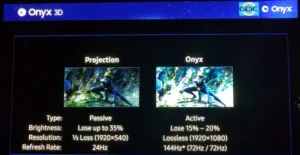Much of the same messaging and information we saw in Los Angeles on our visits to Roundabout and the Winnetka theater (Samsung Launches First U.S. LED Cinema Screen along with Post Production Facility) was repeated at CinemaCon. What was new at CinemaCon was the demonstration of 3D and some content mastered with EclairColor HDR. Samsung also used CinemaCon to brand their LED screen solution “Onyx.”
Samsung set up a closed room on the exhibit floor at CinemaCon to showcase its new Onyx LED cinema solution. This was a 2K screen (2.5 m wide) with a 2.5 mm pixel pitch. Content was mastered at Roundabout using a PQ EOTF and a peak luminance of 300 cd/m². JBL sculptured sound from Harman was the audio solution. Content that was show in the standard presentation:
- Planet of the Apes segment – SDR
- Planet of the Apes segment– HDR
- Alien Covenant segment – HDR
- Black Panther trailer – SDR, 3D
- The Nut Job trailer – SDR, 3D
The Planet of the Apes SDR/HDR demo was good to see how the HDR grade was different. Unfortunately, I did not see a big difference. Most of the mid tones looked the same – maybe some of the dark detail was better, but the luminance of the snow did not seem a lot brighter in HDR than it did in SDR.
The Alien segment was better as the space was deep black and highlights stood out nicely against this dark background.
Samsung’s 3D solution uses active shutter glasses supplied by GDC. Active glasses don’t have a loss of resolution, can operate at high refresh rates and have low optical losses compared to passive 3D solutions. However, the active glasses are not disposable and require cleaning for reuse, so are a more complex logistical solution for theaters.
I don’t like watching 3D trailers as they are too fast paced and slam your eyeballs all over Z space, so distracting and eye straining. As a result, it was hard to judge the quality of the 3D.
Theoretically, Samsung could increase the brightness of the LEDs to compensate for any optical losses in the shutter glasses to deliver a bright, 14fL to the eye – something most projection solutions struggle to do. Samsung was not doing this at CinemaCon, however.
After hours, we were invited back to see some of the content that was mastered with the EclairColor HDR process. This is a gamma 2.8-based solution that according to parent company Ymagis, works well up to 300 cd/m², maybe to 500 cd/m². Content was mastered at 300 cd/m² and two versions of a segment from the movie “Valerian” were created: 2D and 3D.
Since we had a 2D version to compare to, I noticed that on slow moving scenes, the 3D was quite good with no loss of resolution or sharpness. But on faster moving and busy segments, the 3D kind of fell apart. I am not sure if this was a limitation of the special effects, a frame rate issue, an artifact of the 2D-to-3D conversion process, a judder effect due to the higher luminance or just motion blur in 3D. Whatever the reason, it seems the higher contrast and luminance of the LED screen may be accentuating some of the flaws in the 3D. HDR 3D seems like an area that has not been explored in the cinema space too much, so may need more careful consideration. – CC

